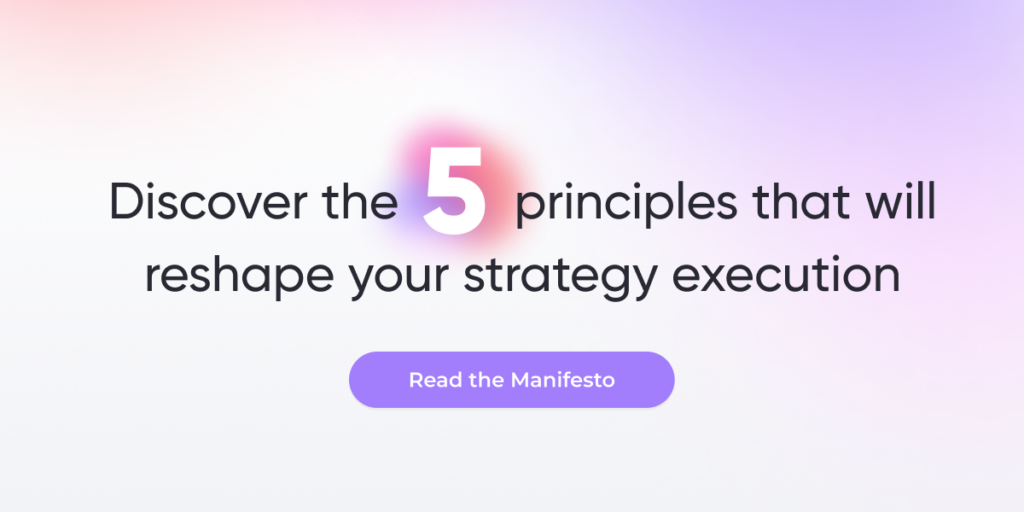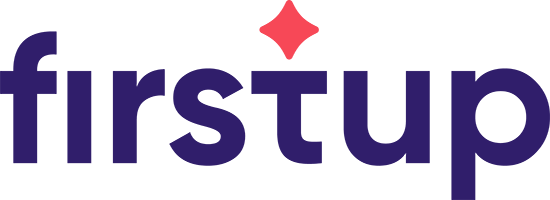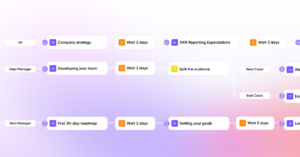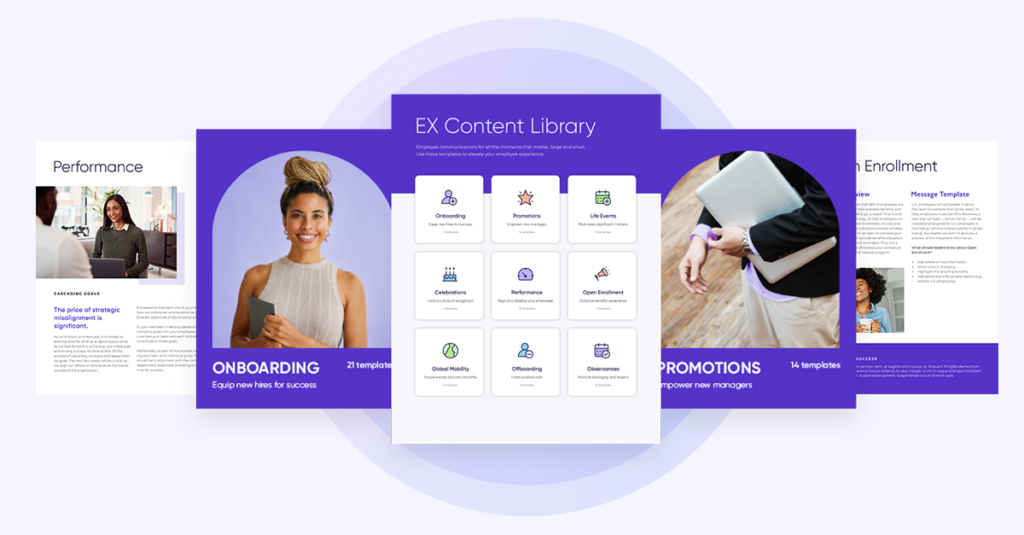In the modern workplace, change is no longer something unexpected or occasional—it’s the norm. Whether that’s shifts in leadership, different technology stacks, or evolving workflows, organizations are changing more, more often, and more quickly.
But when too many changes collide too quickly without clear guidance, support, or communication, it can lead to change fatigue.
This post breaks down what change fatigue is, how to recognize the signs, and what causes it, as well as strategies to overcome change fatigue and drive sustainable momentum for long-term success.
Key Insights:
- Change fatigue and burnout are different but often amplify each other.
- The top causes of change fatigue are too much change, poor communication, and lack of training.
- Key signs of change fatigue include disengagement, resistance, and lower productivity.
- A supportive culture with transparent communication and recognition reduces change fatigue.
- Successful change requires budgeting for communication, training, and employee support.
- Effective change leaders communicate, listen, and empower frontline managers.
- Employee resistance signals concern and can be addressed with clarity, empathy, and autonomy.
What is change fatigue?

Change fatigue occurs when employees feel mentally, emotionally, and physically exhausted due to frequent or poorly managed organizational change.
It’s something more than average, day-to-day stress. Instead, change fatigue happens when people are under pressure to continuously adapt but aren’t given the tools, guidance, or time they need to understand, absorb, and adjust to what’s changing around them.
Worryingly, change fatigue is on the rise. According to a Gallagher poll, 44% of HR leaders called it out as a top-five challenge to success in 2025.
Change fatigue vs. burnout: What’s the difference?
Change fatigue and burnout are related but not the same.
Per the World Health Organization, burnout stems from “chronic workplace stress that has not been successfully managed.” Symptoms include energy depletion, mental distance, and reduced professional efficacy.
Change fatigue, on the other hand, is a specific response to the pace and volume of organizational change. It happens when employees are constantly pushed to adapt to change (such as new tools, structures, leadership, workflows) without the stability or support they need to succeed.
While different, change fatigue and burnout tend to build off each other. For example, one study showed that change-related concerns relate to higher levels of burnout.

Symptoms of change fatigue
Gallup reports a significant increase in employee disengagement, putting many organizations at risk of change fatigue.
How can you tell if your employees are struggling with too much organizational restructuring? Watch for these warning signs:
- Disengagement or apathy: Once active employees may stop asking questions, giving feedback, or actively engaging in new change initiatives.
- Resistance to change: On the opposite end of disengagement, some employees may actively speak out against change, pushing back vocally or ignoring new processes altogether.
- Decreased productivity: According to a Capterra report, 32% of change-fatigued employees report being less productive.
3 causes of change fatigue
In the same Capterra report, 71% of employees say “they’re overwhelmed by the amount of change at their job.” To understand how change fatigue takes hold, here’s a look at the top 3 causes:
- Change saturation
Too much change can lead to chaos—no matter how big or small the change is. From onboarding new tools to welcoming new leadership to shifting internal policies, there are dozens of seemingly small updates that can contribute to change fatigue.
Without the right strategy, leadership, or support in place, each new change—no matter how small—can feel disorienting. Worse, when multiple changes stack up in a short time, they drain energy, strain focus, and overwhelm employees’ abilities to adapt effectively.
- Poor communication
Change without clarity breeds confusion, anxiety, and fear, making poor communication one of the main causes of change fatigue. In fact, in a Gallup survey, 38% of respondents named “poor leadership communication” as a barrier to organizational success, while 39% pointed the finger at “a lack of clear direction from the top.”
Bottom line, when leadership fails to deliver clear communication that explains the purpose, anticipates concerns, and offers guidance, employees disengage. And when employees don’t understand the purpose or value behind a change, they’re more likely to shut down or actively resist.
- Insufficient training
For change to succeed, it requires careful planning and preparation. That means equipping employees with the training, tools, and resources they need to feel confident navigating new technologies, workflows, or responsibilities.
Unfortunately, this is where many companies miss the mark, with 83% of change-fatigued employees saying “their employer doesn’t offer enough tools to support their adaptation to workplace changes.”
Without proper training, new systems or workflows feel frustrating rather than empowering, leading to feelings of overwhelm, more stress, and slower, less productive adoption.
How to deal with change fatigue and get employees to embrace change
Even if your organization is already showing signs of change fatigue, it’s not too late. These strategies can help re-engage your workforce, overcome resistance, and get your team back on the right track and ready to embrace change:
- Build a supportive culture
A supportive culture is the number-one antidote to change fatigue. To help employees begin to regain trust and feel valued during times of change:
- Prioritize frequent, transparent internal communication: Keep messaging consistent, timely, and two-way. Set expectations, ask for feedback, and respond to concerns quickly and compassionately.
- Acknowledge the emotional labor of change: Change is hard and often emotionally draining. Make space for employees to reflect, ask questions, and feel heard.
- Celebrate small wins: To keep employees motivated, take time to recognize their efforts and progress. People stay engaged more when they know they’re making a difference.
Intelligent communication platforms, like Firstup, can help ensure the right messages reach the right people at the right time to increase confidence and alignment.
- Create a culture of innovation
When innovation becomes a part of everyday work life, change is less frightening. To help employees navigate change with confidence, encourage them to:
- Experiment and take risks: Create safe environments where trying something new (and failing) is expected, not penalized.
- Pursue continuous learning: Offer training, peer learning sessions, and mentorship opportunities to encourage curiosity and build employee confidence.
- Be autonomous: Give employees space to choose how they adapt within set parameters, allowing them to take ownership and feel empowered through the change process.
- Budget for change
Like any strategic initiative, change isn’t free. While most organizations budget for new tools and tech, investments in communication, transformation, and change management are often overlooked.
To drive successful change, don’t forget to:
- Allocate time for learning and adoption
- Fund internal communication efforts
- Invest in change-readiness resources, e.g., training documentation or onboarding guides
Plus, employees are more likely to support and engage in change initiatives when they can see their leadership team is invested and committed.
Belonging drives engagement
How to be an effective change leader
Being a change leader is tough. In fact, in an Orgvue report, two in five CEOs said they “would rather quit than lead a large-scale workforce transformation.”
To lead change effectively and help stave off (or rebound from) change fatigue, leaders must:
- Communicate early and often with messaging tailored to each unique audience
- Listen with intention and use employee insights to adapt your approach in real time
- Empower mid-level managers close to the front lines to answer questions and coach others through uncertainty
How to overcome resistance to change and ensure buy in
Resistance is one of the trickiest symptoms of change fatigue—but it’s not always a red flag.
Instead, view resistance more like a signal: Your employees are paying attention and they care about outcomes, but they need help understanding the why and how the change will impact them. Here’s how to help:
- Share the “why”: Engagement rises when employees know the purpose and the benefit of new projects
- Acknowledge fears: Empathy builds trust and puts people at ease, while dismissing concerns sows negativity, fear, and disengagement.
- Give agency: When employees feel ownership, they’re more likely to get involved, stay engaged, and support changes.
How to sustain the momentum for a successful change initiative
When you roll out a new tool, workflow, or other project, don’t just move on after deployment. To make change stick and build lasting impact, it’s important to follow up, stay connected, and actively support teams through the post-launch phase. That includes:
- Offering regular feedback and recognition to reinforce new behaviors
- Reviewing goals and measuring and sharing progress regularly with teams
- Providing continued opportunities for learning and growth to fuel long-term engagement and success
To master change management, reframe change as a strength
There’s been plenty of talk about burnout, but change fatigue is the next organizational challenge that needs attention. When employees face constant change with the tools, time, or support process it, disengagement rises, productivity declines, and momentum stalls.
But change doesn’t need to lead to change fatigue. With careful planning, strategic leadership, and thoughtful, personalized communication that meets every employee where they are with right-time, right-channel messaging that supports and inspires, you can turn change into a competitive advantage.
Learn more about how Firstup can help your team thrive through change.
Deliver a hyper-personalized employee experience at scale
Download PDF








